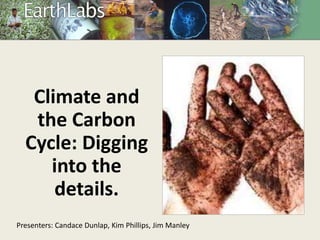
NSTA Boston 2014 PowerPoint presentation slideshare
- 1. Climate and the Carbon Cycle: Digging into the details. Presenters: Candace Dunlap, Kim Phillips, Jim Manley
- 2. Climate and the Carbon Cycle Student pages • http://serc.carleton.edu/esl abs/carbon/index.html Climate and the Carbon Cycle Teachers’ Guide Pages • http://serc.carleton.edu/ear thlabs/carbon/index.html
- 4. The Climate and the Carbon Cycle module is part of a larger set of of Earth science modules in the EarthLabs collection.
- 5. EarthLabs is a project of TERC, an independent, non-profit research and development group in Cambridge, MA. Founded in 1965, TERC’s mission is to improve K-12 math and science education through research, teacher professional development, and curriculum development. (examples: EARTHLABS, EET, CLEAN) www.terc.edu
- 6. Agenda • Introduction to EarthLabs module • Overview of the 8 labs in Climate and the Carbon Cycle module • NGSS alignment examples • Two mini-activities: • Connections Circle Game • Keeling Curve and Carbon Tracker graph analysis.
- 7. • The module is composed of eight sections, called “Labs” • Learning activities are varied and include: – Hands-on experiments – Interactive visualizations – Videos – Data and graph analysis – Readings – Discussions – Case studies
- 9. NGSS Crossing Cutting Concepts • Complex Systems • Causality • Patterns • Claim, evidence and argument • Scale
- 11. Sample NGSS alignment of DCIs, Crosscutting Concepts and Science and Engineering Practices ESS2.D Changes in the atmosphere due to human activity have increased CO2 concentrations and thus affects climate. LS2.B Photosynthesis and cellular respiration are important components of the carbon cycle in which carbon is exchanged among the biosphere, atmosphere, oceans and geosphere through chemical, physical, geological and biological processes. Analyze geoscience data to make the claim that increased CO2 concentrations is caused primarily by the burning of fossil fuels (cause and effect) Develop a model to illustrate role of photosynthesis and cellular respiration in the cycling of carbon among the biosphere, atmosphere, hydrosphere, and geosphere (LAB 2 (A,B) LAB 4B LEARNING EXPERIENCES/ASSESSMENTS
- 12. Crosscutting Concept: Stability and Change Systems and Feedback • ESS2-1 Earth’s systems, being dynamic and interacting, cause feedback effects that can increase or decrease the original changes. Analyze geoscience data to make the claim that one change to Earth’s surface can create feedbacks that cause changes to other Earth systems(i.e. changes in vegetation, changes in atmospheric CO2 etc.) LAB 2B, 5B, 7A CONNECTIONS GAME – LAB 2B Create a model that illustrates feedback mechanisms in a pine bark beetle infestation of western forests - LAB 2B LEARNING EXPERIENCES, ASSESSMENTS
- 15. LAB 1A How do these redwood cone seeds grow into the world’s largest trees? ??????????????? Carbon in Carbon out
- 16. Digging Deeper – Lab 1B Building and visualizing biomolecules and biosphere processes Photosynthesis Cell Respiration Biosynthesis! DNA gets N, P, Mg and H atoms from soil. Where does it get its carbon atoms from?
- 17. Lab 2: Carbon Cycle: Where does carbon go, how does it get there, how does it change, how long does it stay? • Terrestrial (Forest) Carbon Cycle Game (UCAR) • Global Carbon Cycle interactive • Identifying C.C. feedbacks using a Pine Bark Beetle case study Regional, terrestrial Behavior in complex systems Global Spatial Scale Time Scales
- 21. Connections Game: Modeling the Behavior of Complex Systems
- 29. A feedback acts upon the original change to amplify it(reinforce) or dampen it. Original Change
- 30. LAB 3- My Life as a greenhouse gas!
- 31. LAB 3A Why do greenhouse gas molecules absorb infrared but oxygen and nitrogen do not?
- 32. Carbon Tracker Activity : Competing claims- It’s us! It’s not us!
- 33. Keeling Curve (Lab 3B) Keeling Curve Source:NOAA
- 34. Mauna Loa –Time series
- 36. LAB 4 How do changes in the land affect the carbon cycle? • Wildfires • Deforestation • Solutions to Slash and Burn - mini case study • Global Forest Watch – Inquiry project • Case study: Ecological changes in a Boreal Forest
- 44. LAB 5 Soil and the Carbon Cycle
- 45. Soil Lab (Lab 5A) • Students will design and carry out an experiment testing one of the environmental variables that influence decomposition and soil respiration rates.
- 47. Lab 6 The ocean carbon cycle
- 48. Lab 6 The ocean carbon cycle
- 49. Phytoplankton blooms Boreal Summer
- 51. Lab 7 Ocean Acidification
- 52. Acidic Alkaline Surface seawater pH scale 10 32 54 76 98 10 1211 1413 Present day Predicted for 2100 under ‘business as usual’ pH scale for maps FromTurley&Findlay(2009) Pre-industrial Lab 7 Ocean Acidification -
- 53. Lab 7 B VirtualUrchin
- 54. Balancing the carbon cycle: Finding solutions with design and technology
- 57. THANKS! Thanks for joining us! The urls for the Teachers’ Guide and the Student pages are on the Earthlab bookmarks
- 58. Climate and the Carbon Cycle Student pages • http://serc.carleton.edu/esl abs/carbon/index.html Climate and the Carbon Cycle Teachers’ Guide Pages • http://serc.carleton.edu/ear thlabs/carbon/index.html
Hinweis der Redaktion
- Brand new forest change map Can research different spatial scales of change – global, hemisphere, country, region, neighborhood Many different variables to explore (
- Pictures I took while on a research cruise with Dr. Maureen Conte off of the island of Bermuda. She is studying the changes in the amount of organic debris falling though the water column.
- PPTX slide Credit goes to Dr. Gretchen Hofman There is a link to her powerpoint in the teacher pages